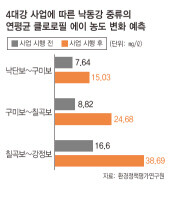hankyoreh
Links to other country sites 다른 나라 사이트 링크
Four Rivers project will contaminate water sources, NIER report says

By Nam Jong-young
A national policy research body has found that if the Lee Myung-bak administration’s controversial Four Major Rivers Restoration Project is completed, the concentration of chlorophyll a will increase greatly in the Nakdong River. Chlorophyll a is an index of eutrophication, a process in which a body of water acquires a high concentration of nutrients, promoting the excessive growth of algae, depriving other organisms living in the river of oxygen. The National Institute of Environmental Research (NIER) conducted a water quality prediction model at the behest of the Lee administration as part of its Four Major Rivers Restoration Project master plan and environmental impact assessment, but as chlorophyll a was not a legally required subject, the result was not released. The report is expected to generate controversy due the publicized findings.
Ahn Jong-ho of the Korea Environment Institute (KEI) revealed this in a report on water quality control efforts to combat global climate change released Monday, saying this was the predicted riverine environment change that would result from the construction of eight weirs and dredging on the Nakdong River. The report was read at symposium on water security strategy and the response to climate change held at the Korea Chamber of Commerce & Industry headquarters in Seoul’s Jung-gu neighborhood.
The report first said that the river water would stay much longer during the dry season and in mid-stream due to the weir construction and dredging on the Nakdong River. In fact, predictions made on the 11 sections of the Nakdong River showed that while prior to the project, in no section did the water stay for more than 20 days, after the project, the water would stay for over 20 days in ten sections.
It was revealed that with the water of the Nakdong River flowing slower, the concentration of chlorophyll a would increase. In particular, it would increase two-to-four fold in the upper and middle streams. If there is a lot of chlorophyll a in the river, algae that cause green tide would gives off a nasty smell. The concentration of chlorophyll a in the area between the Gumi and Chilgok weirs was 2.64mg/l in December, the dry season prior to the project, but after the project it was 10.66mg/l, a four-fold increase. The concentration between the Nakdan-Gumi and Chilgok-Gangjeong weirs was predicted to more or less double on average. The report said that as a result of the Nakdong project, the chlorophyll a upstream to the Hapcheon weir was increasing, while in the Nakdong River estuary it was decreasing. The report presumed that the reason for the decrease downstream was that the estuary barrage was increasing water depth rather than water transit time, and this was decreasing sunlight penetration and disturbing algae growth.
The Lee administration has claimed that if the “water bowl” is made larger by building eight weirs and digging out the riverbed, it would improve water quality on the Nakdong River by diluting pollutants. The report conclusions, however, suggest that rather than cleansing the “water bowl,” the project would worsen water quality by encouraging algae to grow in the stagnant water. Moreover, with levels of BOD5, T-N and T-P predicted to improve only slightly or remain the same, the project, with 5.2 trillion Won being invested into weir construction and dredging, is losing its economic basis.
In response, the Korea Environment Institute released a separate press statement saying the chlorophyll a concentration numbers did not take into account the T-N processing facilities. If these facilities are installed, the numbers would improve.
However, Lee Cheol-jae, the policy director of the Korean Federation for Environmental Movement (KFEM), said, “The T-N facility handles only point source pollution, it cannot stop non-point source pollution.”
Lee added, “The administration’s logic that the water quality would improve if the ‘water bowl’ was enlarged has been shown to be empty.”
Please direct questions or comments to [englishhani@hani.co.kr]
Editorial・opinion
![[Column] Park Geun-hye déjà vu in Yoon Suk-yeol [Column] Park Geun-hye déjà vu in Yoon Suk-yeol](https://flexible.img.hani.co.kr/flexible/normal/500/300/imgdb/original/2024/0424/651713945113788.jpg) [Column] Park Geun-hye déjà vu in Yoon Suk-yeol
[Column] Park Geun-hye déjà vu in Yoon Suk-yeol![[Editorial] New weight of N. Korea’s nuclear threats makes dialogue all the more urgent [Editorial] New weight of N. Korea’s nuclear threats makes dialogue all the more urgent](https://flexible.img.hani.co.kr/flexible/normal/500/300/imgdb/original/2024/0424/7317139454662664.jpg) [Editorial] New weight of N. Korea’s nuclear threats makes dialogue all the more urgent
[Editorial] New weight of N. Korea’s nuclear threats makes dialogue all the more urgent- [Guest essay] The real reason Korea’s new right wants to dub Rhee a founding father
- [Column] ‘Choson’: Is it time we start referring to N. Korea in its own terms?
- [Editorial] Japan’s rewriting of history with Korea has gone too far
- [Column] The president’s questionable capacity for dialogue
- [Column] Are chaebol firms just pizza pies for families to divvy up as they please?
- [Column] Has Korea, too, crossed the Rubicon on China?
- [Correspondent’s column] In Japan’s alliance with US, echoes of its past alliances with UK
- [Editorial] Does Yoon think the Korean public is wrong?
Most viewed articles
- 1‘We must say no’: Seoul defense chief on Korean, USFK involvement in hypothetical Taiwan crisis
- 2N. Korean delegation’s trip to Iran shows how Pyongyang is leveraging ties with Moscow
- 3[Column] Park Geun-hye déjà vu in Yoon Suk-yeol
- 4Amnesty notes ‘erosion’ of freedom of expression in Korea in annual human rights report
- 5‘Weddingflation’ breaks the bank for Korean couples-to-be
- 646% of cases of violence against women in Korea perpetrated by intimate partner, study finds
- 7[Reportage] On US campuses, student risk arrest as they call for divestment from Israel
- 8“Parental care contracts” increasingly common in South Korea
- 9[Interview] Dear Korean men, It’s OK to admit you’re not always strong
- 10Korean government’s compromise plan for medical reform swiftly rejected by doctors